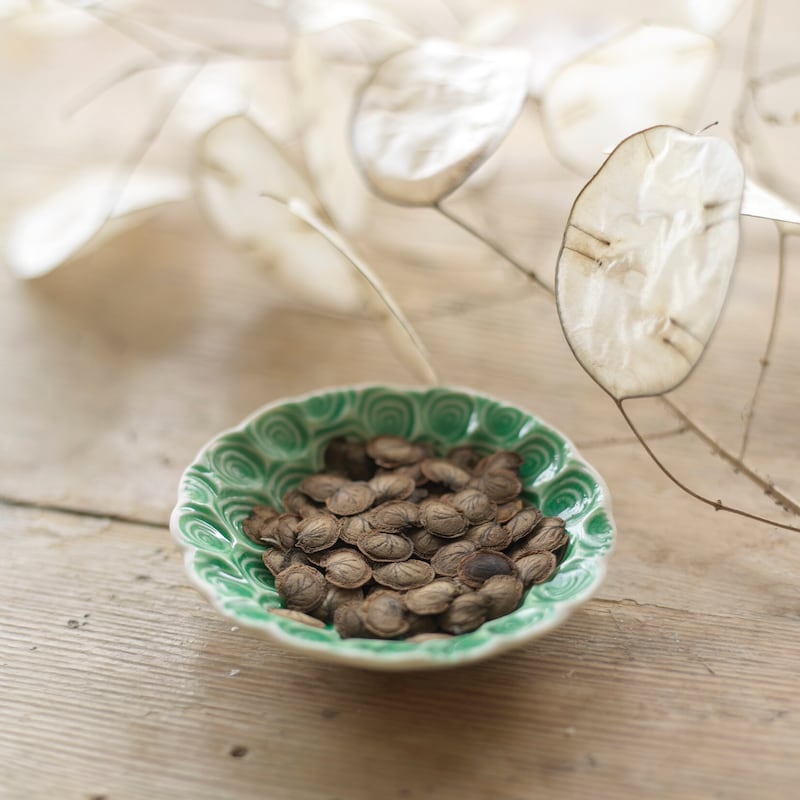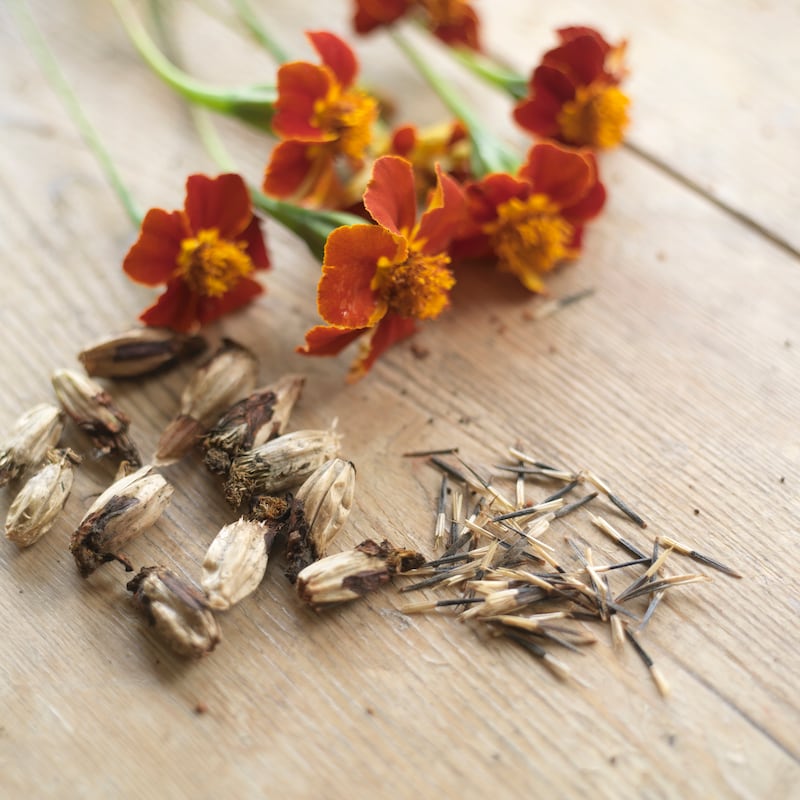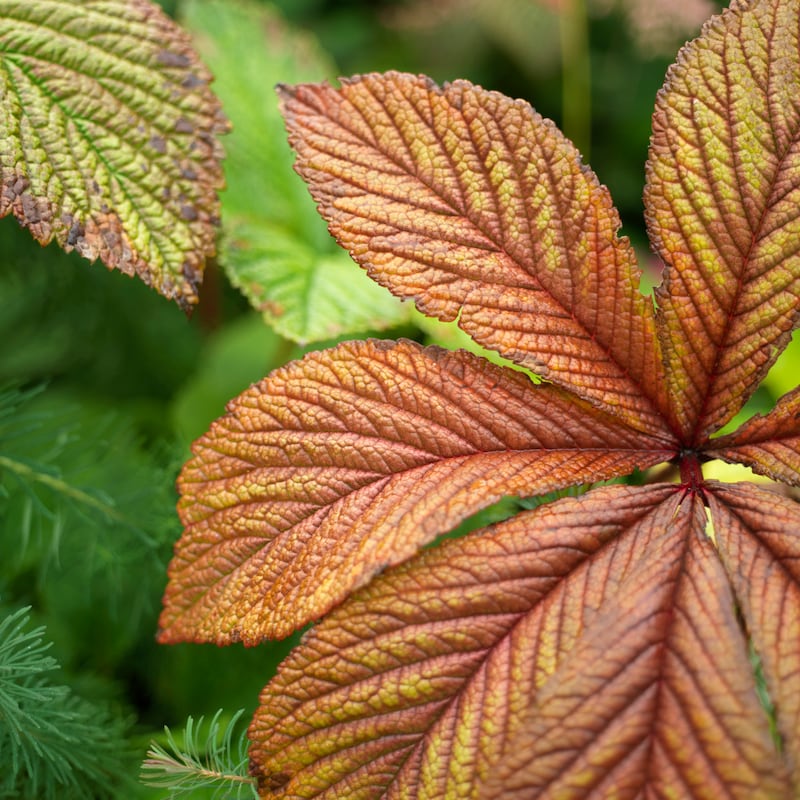It was the late great fashion designer Coco Chanel who declared that the best things in life are free. Certainly one of the great joys of gardening is the boundless generosity of the plant kingdom.
It gives us food, flowers, fresh air and in its overriding urge to reproduce, allows us to successfully employ all manner of ingenious methods of propagation – seed, division, cuttings, layering, grafting, budding – to produce new plants for free.
Just consider the abundance of ripe, viable seed that fills our gardens (and keen gardeners’ pockets) at this time of year as many plants’ annual cycle of growth/flowering/fruiting comes to its natural reproductive end.
Examples include the seed of short-lived annuals/ biennials such as ammi, centaurea, calendula, tagetes, sweet pea, poppies, cynoglossum, scabious, cosmos, ipomaea, dill, nigella, lunaria, nicandra, sweet William, tomato, chilli pepper; perennials such as astrantia, linaria, echinacea, sweet rocket, stipa, eryngium, Japanese anemones and verbena and woody/shrubby species such as sorbus, magnolia, eucryphia, viburnum and crataegus.

Stratification and exposure
As long as it’s not from a hybrid variety, saving it is often just a simple matter of harvesting on a dry day by dropping the ripe seedheads/pods into a labelled paper envelope and storing it somewhere cool, dry and dark until needed; for example, in a small waterproof, lidded box in the fridge.
Some species, it’s true, require a little additional work. For example, to successfully harvest or prepare tomato seed, you’ll need to empty the soft, juicy pulp of the ripe fruit into a small bowl, add a little water, stir and then leave it in a warm room to gently ferment for a few days before tipping the contents into a sieve and rinsing with clean water to expose the viable seeds.
Likewise the seed of some plants – for example magnolia – comes with a fleshy outer coating that needs to be removed to encourage germination. Certain other species (sometimes known as cold germinators) need a period of stratification/exposure to cold temperatures to successfully germinate (see the seedsite.co.uk; howtosaveseeds.com and perennials.com for specific details). But the small amount of extra labour is a very small price to pay for the rich rewards.
Even simpler again is division, a time-honoured method of vegetative propagation suitable for many perennial plants and some species of shrubs, where the mature/established plant is carefully divided into individual smaller sections (each with its own root system attached) and these are then quickly potted or planted out in the garden or allotment.
Not only is division a great way of producing a host of genetically identical new plants for yourself and your gardening friends, it also reinvigorates any plants that have become overly large and woody at their centre.

Oft-quoted rule
It doesn’t have to be a plant in your garden. Indeed this is the perfect time of year to seek out pot-bound perennials in garden centres (you’ll also often get them at a reduced price) for the express purpose of propagating them by division. Consider it the horticultural equivalent of the loaves and the fishes; all it takes is a sharp knife, garden fork or spade or even a small saw.
Just bear in mind the oft-quoted rule which is that most (not all) spring and early summer-flowering perennial species should be divided in autumn while most (not all) late-summer/autumn flowering species should be divided in spring.
October is also a great month to take hardwood cuttings of roses, fruit bushes, deciduous shrubs and trees.
Unlike division (where each part of the parent retains a section of root system), these cuttings will generate their own new independent root systems if/when given the right conditions. For best results, use a sharp secateurs or knife to take young, healthy, non-flowering cuttings (15-30cm long and no thicker than a pencil) from the parent plant, cutting just below a leaf node.
Place these quickly into a sealed freezer bag dampened with a little water until you’re ready to plant them by plunging the upright cuttings 2/3 deep into a 2L plastic pot filled with a good quality seed and cuttings compost lightened with pre-dampened perlite and then watering it well.
Place an upturned 3L freezer bag around the rim of the pot and fix it in place with an elastic band to create a sealed tent or mini-biodome; this provides the sort of moist, humid atmosphere conducive to rapid root development, especially if you can give your cuttings gentle bottom heat by placing the pot on a heated plant propagator.

The speed at which the new roots will develop depends on the particular species as well as the type of cutting; hardwood cuttings taken in autumn/ early winter are slowest and typically take several months. Certain kinds of plants (for example, magnolias and camellias) are difficult to propagate from cuttings. In this case, try the inexpensive and ingenious Irish-designed device known as the Cutting Globe, which makes use of the propagation method known as air layering (cuttingglobe.com).
Canny gardeners also know that autumn is a great time to seek out self-sown seedlings and baby plants, which can often be found growing in clusters close to the skirts of their parent plants at this time of year. Gently lifted using a trowel or garden fork, these can either be potted on until required or transplanted into a more suitable position elsewhere in your garden or allotment.
Alternatively you could pay it on by giving some away to an appreciative gardening friend or your local garden club. This way it becomes the gift that keeps on giving.
This Week in the Garden
Now that it’s mid-October it’s time to start clearing summer crops such as courgettes, tomatoes, cucumbers and French beans out of the polytunnel/glasshouse as part of a general autumn tidy-up. You can fill that newly-freed growing space with other edible crops such as winter-hardy varieties of lettuce, oriental salad leaves, Swiss chard, claytonia, calabrese, annual spinach, Florence fennel, chervil, coriander.
Alternativly plant tulips, ranunculus or anemones to give you an extra early cut-flower crop, making sure to replace lost soil nutrients before planting by adding a shallow mulch of well-rotted manure/garden compost and a generous sprinkle of organic pelleted manure.
October is a month of more subtle pleasures in comparison to the high octane colours of the summer garden, but that’s not to say it’s without its own special kind of beauty. In particular this is a month to enjoy the vividly colourful display of autumnal foliage as deciduous trees, shrubs and herbaceous plants make their slow transition into winter dormancy.
Examples of plants that give outstanding displays of colourful seasonal foliage at this time of year include hostas, the royal fern (Osmunda regalis), Astilbe arendsii, goat’s beard (Aruncus dioicus), euonymus. enkianthus, Viburnum opulus, rodgersia, mountain ash (Sorbus), Persian ironwood (Parrotia persica) , Japanese maple, sweet gum (Liquidambar) and the katsura tree (Cercidiphyllum japonicum)
Do this
Considered one of the highlights of the Irish gardening year, Mr Middleton's Annual Autumn Garden Masterclass takes place next Saturday 19th October (9am-5pm) at City West Hotel, Saggart, Co Dublin. This year's host of expert speakers lined up for the event includes the renowned west Cork-based award-winning author and kitchen garden expert Joy Larkcom, plantsperson, gardener and author Jimi Blake of Hunting Brook Gardens in west Wicklow, John Anderson, Keeper of Windsor Great Park & Windsor Castle Gardens, Angela Jupe, plantsperson, landscape architect, director of the RHSI and owner/creator of Bellefield Gardens in Co Tipperary, and Thomas Quearney, plantsperson and founder of Mr Middleton, one of the country's longest-established garden shops. Tickets are €90, includes lunch and refreshments, pre-booking essential.
mrmiddleton.com
Dates For Your Diary
So Many Plants, So Little Space
Wednesday, October 16th, 8pm
The Marine Hotel Sutton, Dublin 13
hshs.ie
A talk by Bob Brown of the UK's Cotswold Garden Flowers on behalf of Howth and Sutton Horticultural Society followed by plant sale.
Tales from the Bird World
Wednesday October 16th, 8pm
Parish Centre, Church Road, Malahide, Co Dublin malahidehorticulturalsociety.com
A talk by the zoologist and ornithologist Dr Richard Collins on behalf of Malahide Horticultural Society.
Floral Art Demonstration
Wednesday October 16th, 8pm
Wesley House, Leeson Park, Dublin 6
rhsi.ie
A demonstration by Paula Dowling on behalf of the RHSI, all welcome, admission €10 for non-members.
To the Mountains of Myanmar
Wednesday, October 23rd, 8pm
Wesley House, Leeson Park, Ranelagh, Dublin 6
rhsi.ie
A lecture by Seamus O' Brien, author, horticulturist and head gardener of Kilmacurragh Botanic Gardens, Co Wicklow on behalf of the RHSI.




















